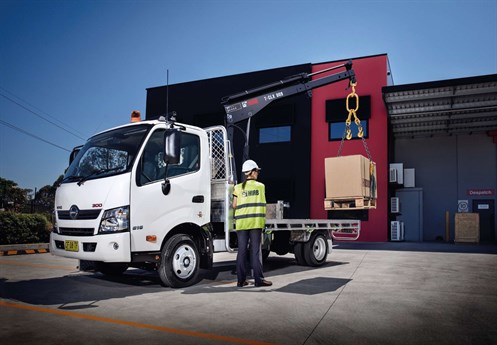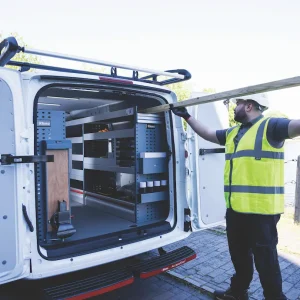Being able to swing a bag full of sand or gravel off the back of a 3.5t dropside, over a fence and drop it in a customer’s garden brings all sorts of advantages: it’s quick, eliminates the physical effort that would otherwise be required, and means a driver can make the delivery solo without the need for a mate.
That reduces the wages bill, and the speed with which deliveries can be accomplished means more can be made in a day.
Those are among the benefits that having an onboard loader crane fitted can bring, says Penny Hydraulics. Its PH loader cranes, suitable for 3.5t dropsides and tippers, can hoist over 2,000kg depending on the version selected. Bear in mind that the further away from the vehicle you want to place a load, the less you will be able to lift. Even so, the weight you will be able to deposit is likely to be quite substantial.
Opt for the PH180.2, for example, and specify the appropriate manual extension and you can lift a 280kg load and drop it down 5m away. Penny Hydraulics also offers a range of SwingLift cranes that can be mounted just inside the side and rear doors of vans, with lifting capacities of up to 500kg.
Loader cranes have one or two drawbacks. The PH180.2 weighs up to 200kg depending on specifications and that eats into your vehicle’s payload capacity – a critical consideration given how tight 3.5-tonners are on payload to begin with. It draws power too, so you will need to have a protection device installed to ensure you do not end up with a flat battery.
Remember too that extendible stabilisers will probably have to be fitted and deployed before a crane like this is used, to stop your vehicle toppling over. Both they and the loader crane must be properly stowed before you drive away, and a warning system should be installed to alert the driver if they have not been stowed correctly.
Nobody should be let loose with a crane of any description without having been properly trained first. PUWER (the Provision and User of Work Equipment Regulations 1998) obliges employers to ensure that staff using work equipment receive adequate instruction. Your supplier should be able to advise you about suitable training courses. It may also be worth contacting the Association of Lorry Loader Manufacturers and Importers (ALLMI – head to www.allmi.com). There is a list of training providers on its website. PUWER also obliges businesses to ensure that their cranes are in good repair.
Using suitable mechanical handling aids minimises the risk of musculoskeletal injuries. No responsible business wants a valued employee off sick for weeks because of a back injury or a severely wrenched shoulder.
“Thirty-five per cent of all work-related illnesses are musculoskeletal disorders (MSDs),” points out Penny Hydraulics sales director Richard Short, who is also an ALLMI board member. “That equates to over 469,000 workers suffering from work-related MSDs in 2017/18 and over 6.6 million working days lost according to the government’s Labour Force Survey.”
Penny Hydraulics is not the only company that supplies cranes suitable for light commercials. Though better-known for its big-capacity models, Hiab offers smaller variants too, including the T-009. It can lift 870kg close-in and 240kg at a full outreach of almost 4m.
“Who needs an assistant to handle back-breaking loads?” Hiab wonders.

Hiab’s T-009 in action
(Continued from previous page) Tipper bodybuilder Tipmaster markets the Swift Lift, which can raise up to 300kg alongside its Tommy Lift range of tail-lifts with capacities of up to 500kg.
Speed of delivery, the greater ability for drivers to make deliveries unaccompanied and the reduced risk of injuries caused by heaving about heavy objects are all good reasons for equipping a van with a tail-lift, depending on the type of delivery involved.
It too should be accompanied by battery protection. As is the case with a crane, a tail-lift’s weight will reduce the vehicle’s payload capability.
Crane and tail-lift manufacturers are continually attempting to cut the weight of their products without compromising their lifting capacity or durability, with some of Penny’s tail-lifts weighing no more than 60kg. They are doing so through more intelligent design and the use of plastics, aluminium and high-strength steel where possible and practical.
Hiab, for example, reckons it has reduced the weight of its latest DEL DL500 column tail-lift by 10% without reducing its ability to lift 500kg loads. It also makes the point that the newcomer is equipped with a quieter chain roller; the quieter a tail-lift is, the more likely it is to be acceptable for making deliveries at night.
Launched at this year’s CV Show, the DL500 can be specified with safety guards that deploy automatically when the lift is used, to stop an operator standing on the platform tumbling off.
Adding options increases tail-lift weight, but weight savings can be achieved on box and Luton bodies by deleting the rear barn or roller shutter doors and using a lift platform as the rear closure instead. It can be supplemented by a flap to bridge any gap between the platform’s edge and the body’s roof when the platform is stowed.
Aluminium platforms make sense if weight-saving is a key consideration, and have the added advantage that they do not corrode. They may not be the right choice if the vehicle is being used to collect cargo such as industrial waste, however, says hydraulic equipment supplier Dhollandia. A robust steel platform may be a better choice, it suggests. As a consequence it offers a dump-over version of its DH-VO.07.K1 500-750kg-capacity column lift, which can be fitted to a tipper and has a foldable steel platform. Fold it, and it does not get in the way when the tipper’s body is raised and its contents are discharged. Other lift manufacturers – Tommy Lift, for example – have dump-thru or dump-over models for tippers in their line-ups too.
PUWER applies to tail-lifts in the same way that it does to cranes. Furthermore, LOLER (the Lifting Operations and Lifting Equipment Regulations 1998) requires cranes and tail-lifts to undergo periodic thorough examinations by ‘a competent person’ – an appropriately qualified engineer, for example – to ensure that they remain fit for use.
Prices for cranes and tail-lifts vary depending on how much lifting capacity you require. Penny’s PH cranes start at around £3,000, while one of its tail-lifts capable of raising 500kg will set you back roughly £2,500 to £3,000.
While tail-lifts can reduce the risk of musculoskeletal injury, paradoxically they can also raise operational safety concerns. Some businesses delivering palletised loads using vehicles with a driver on his or her own, a tail-lift and a manually operated pallet truck have limited the weight of the full pallets they will handle to 750kg. Anything heavier is too much for an individual employee to handle without assistance or better equipment – a power-operated pallet truck and an extra-large lift platform, for instance – they contend.
Their concerns have arisen in the wake of the death of a delivery driver in 2016 while unloading a pallet of goods weighing upwards of a tonne.
Admittedly the majority of tail-lifts fitted to light commercials have a capacity no greater than 500kg. Deduct the weight of the driver and the pallet truck, however, and that still means you could be dealing with pallets weighing over 350kg – and whoever is loading or unloading them needs to be trained accordingly.
Not sure how much that pallet of goods weighs? Suspect that it may be heavier than the label says it is? Then it is worth noting that Avery Weigh-Tronix has launched the PTS2000S pallet truck scale, which enables a pallet to be weighed while it is being moved. The scale has Legal for Trade status says the firm.
This means that if you are delivering goods for a third-party and charging them by weight, you can legitimately surcharge them if the weight has been under-declared. Wireless and Bluetooth connectivity allow for the instant transfer of weight data from the scale to the user’s back-office – avoiding the errors often associated with manual data input.





